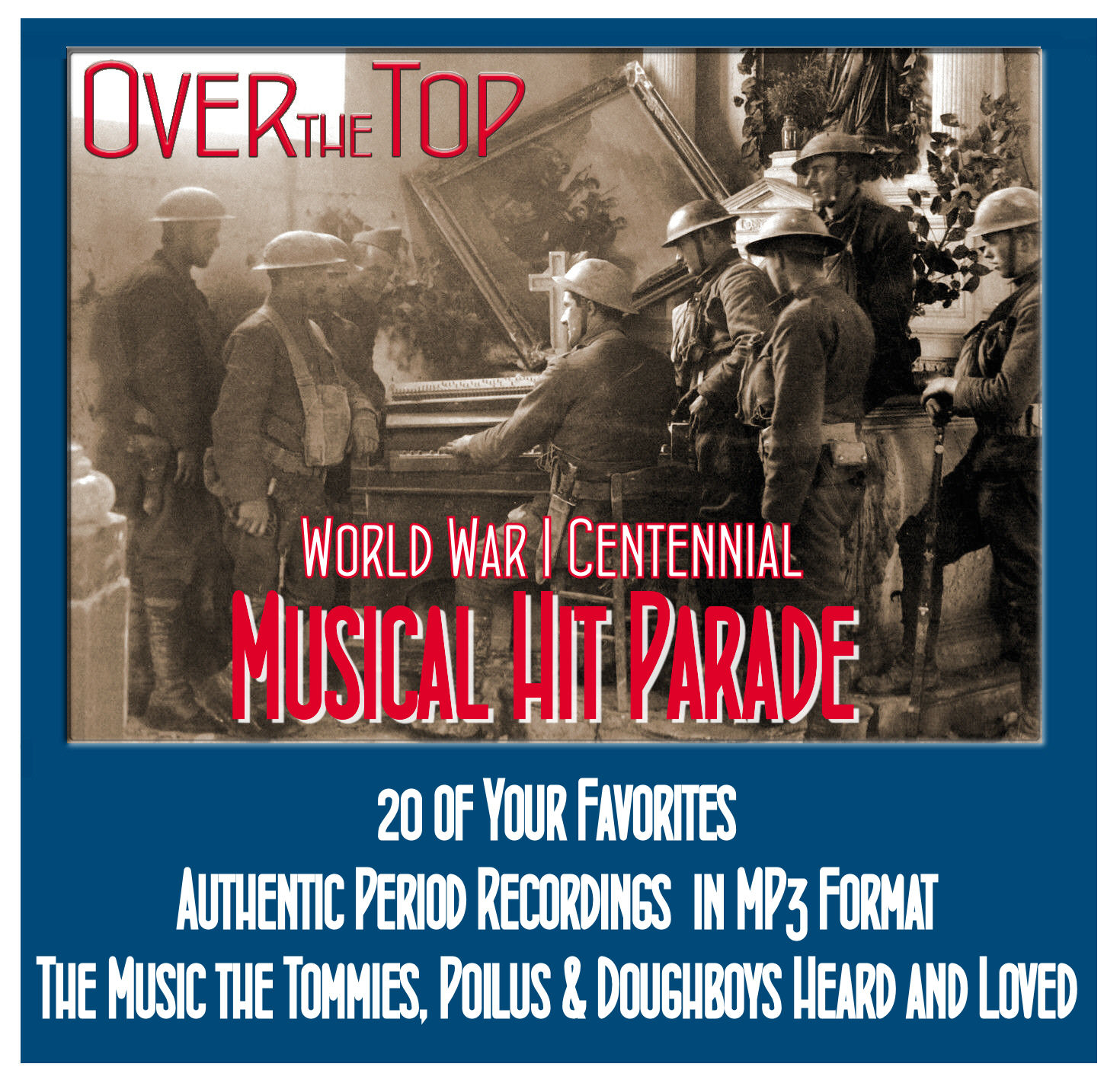
January |
Access |
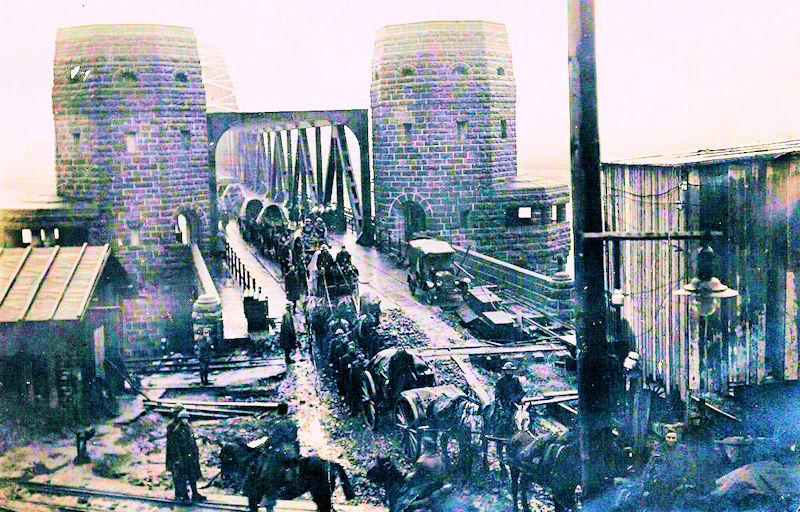
The Occupation Begins: The 42nd Rainbow Division Crossing the Rhine
|
||||
 Peter Jackson (Hobbit-Like Producer) |
TSNGO, however, also offered surprise after surprise for the audience. It began with Jackson's utterly charming and insightful introduction in which he described how the project came about and evolved, his personal stake in the production, and how he eventually saw the endeavor as a presentation–not of battles–but of what it was like to actually fight in the war. I breathed a big sigh of relief when I realized we would be spared the usual cant about the war–that it was a meaningless tragedy and that everyone who served in it was killed, maimed, or driven mad. Another element that surprised me was the number of sequences that stirred an intense visceral reaction—a virtual "You are there" feeling. I remember the footage of a squad of troops ducking down on one side of a low berm as a series of artillery shells hit and exploded just on the other side of the dirt pile. Jackson even held one additional treat for the audience until after the credits, when he conducted a master class on the new state of the art in documentary film-making. Luckily, They Shall Not Grow Old will be coming back to America this month, first in some limited markets, (NY, DC, LA) and later in 21 sites around the country. Needless to say, I plan to see it again, and, maybe, again. MH

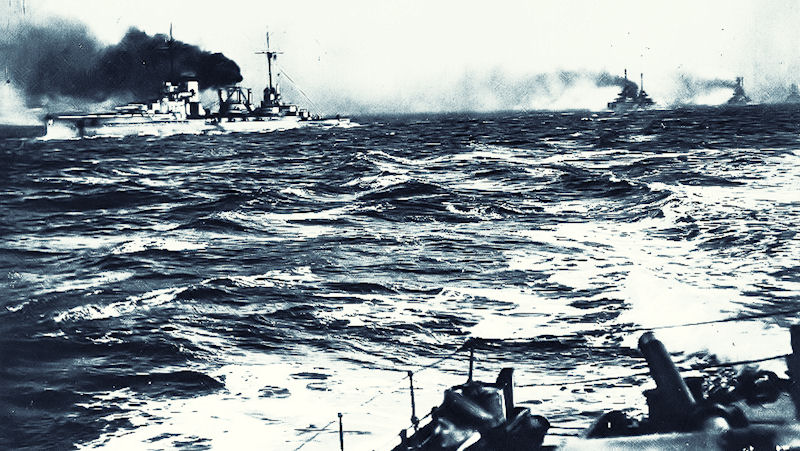
The High Seas Fleet Surrenders: 21 November 1918
About 9.30 precisely came the great
moment–the first glimpse of the captive
German fleet. The lookout man at the
masthead called down the tube to the
captain's bridge: 'German fleet in sight
on the starboard bow.' We were fifty
miles out to sea east of the opening of the
Firth of Forth. 'Der Tag,' murmured the
chief yeoman of signals, as he leveled his
telescope on the incredible thing. First of
all we saw a kite balloon towed along by
the Cardiff, our light cruiser, in the proud
job of marshaling the prisoners. Behind
the Cardiff we saw a faint silhouette,
dark gray against the gray haze, like
something cut out of paper. 'Seydlitz,'
said an officer. 'When I saw her last she
was fairly battered. Jutland.' So the five
battlecruisers were marching first to
prison.
Over the Seydlitz one of our North Sea
airships kept watch and ward. The leading German ships showed great plumes
of smoke. After the Seydlitz came the
Moltke, Derfflinger, Hindenburg, and Von
der Tann. They were about three miles
from us.
'What a target!' said our captain regretfully, and he made a rapid calculation of how long it would take our thirty-three battleships to sink their nine. The
nine now loomed out of the haze, all moving as at some peaceful maneuvers. They
were in this order: Friedrich der Grosse,
flying the flag of Admiral von Reuter;
Kaiser, Konig Albert, Prinzregent Luitpold, Kaiserin, Bayern (the very latest),
Grosser Kurfurst, Markgraf, Kronprinz
Wilhelm.
The grandest sight was that of the nine
battleships towering in the misty light,
magnificent and also ignominious. Soon
after they were visible the sun burst out
fully and made a path of rippling dazzle
between us and the Germans. The phlegm
of the British sailor was proof even against
this miracle. Round me, the officers were
calmly identifying the ships from their
silhouette-books–'See the Derfflinger's
tripod masts,' and so on. Our sailors
showed no emotion at all. There was not
a cheer in all the British fleet, although
everywhere, on every turret and ledge,
the men stood thickly, gazing silently or
with some casual jest.
One man who said
to me, 'This is what we've been waiting
for all these years' was an exception. The
sailorman thought of peace to come and
leave at last. There was chivalry in his
heart for a beaten foe. I heard one say:
'It's a fine sight, but I wouldn't be on
one of them ships for the world.' An officer said to me: 'We all feel this is an
unparalleled humiliation to a great fleet.
The High Seas Fleet has fought well, and
we have nothing against it. The submarines are another story. We have won the
greatest and the most bloodless victories
in the history of the world.'
There was a gap of three miles between
the battleships and the seven light cruisers. These we could not see at all, nor
the fifty German destroyers, all of the
latest type, that closed the pageant. . .
Source: F. Perrot, "Watching the Great Surrender," The Lotus , February 1919, 70-76.

The Occupation of the Central Powers
The terms of the 11 November 1918 armistice required Germany to evacuate all invaded and occupied territory in Belgium, Luxembourg, and France (including Alsace-Lorraine), and to withdraw her armies across the Rhine.
They also provided that the Allied forces should be permitted to occupy bridgeheads, 18 miles in radius, east of the Rhine at Mayence, Coblenz, and Cologne, and that a neutral zone six miles wide in which neither the Allies nor Germany could maintain troops would be established along the east bank of the Rhine and around each of the bridgeheads. Occupation of specific and "strategic" points by the Allies was addressed in the 30 October 1918 Mundros Armistice.
![]() Allied Advance to the Rhine, 1918 (PDF)
Allied Advance to the Rhine, 1918 (PDF)
![]() Occupation of the Rhineland
Occupation of the Rhineland
![]() The Occupation of the Ruhr (Germany, 1923-1925)
The Occupation of the Ruhr (Germany, 1923-1925)
![]() Occupation of the Rhineland and Ruhrgebiet (1918-1930)
Occupation of the Rhineland and Ruhrgebiet (1918-1930)
![]() Occupation of Constantinople
Occupation of Constantinople
![]() The Greek Occupation of Smyrna
The Greek Occupation of Smyrna
![]() The U.S. Third Army in Germany (PDF)
The U.S. Third Army in Germany (PDF)

Long After, a Veteran Reflects on the Great War
Myself, I valued the Kaiser's war as having given me not only an unsurpassable standard of danger, discomfort and horror by which to judge more recent troubles, but a confidence in the golden-heartedness and iron endurance of my fellow-countrymen (proved again during Hitler's war), which even the laxity of this new plastic age cannot disturb.
Robert Graves

Despite my retirement from the business, there will still be possibilities for you to visit the battlefields of the Great War.
AEF Battlefields
2019
From: Valor Tours, Ltd. / Mike Grams, Tour Leader
When: September 2019
Details: Download trip brochure HERE.
Comprehensive Western Front Tour
From: Orinda CA, Travel / Frank Jordan, Tour Leader
When: 19 May – 1 June 2019
Details: Download trip flyer HERE. (11 January 2018 is the final day for deposits.)

Check here for information on showings of They Shall Not Grow Old. As of 1 January, Warner Bros. will launch limited theatrical releases in NYC, LA, and Washington, DC, starting on 11 January, with plans to then expand into 25 more markets on 1 February.
Take a Virtual Visit the National World War I Memorial in Washington, DC ,
HERE
By the way, the memorial is not yet fully funded. This site also has information on how you can make a personal contribution to its completion.
Visit Our Daily Blog

Click on the Image to Access
Looking Back: A Retrospective of the War
Part I
During 2019 we will be presenting a recapitulation of the major events of the war from an American perspective. For this purpose we are lucky to have available to us a series of dramatic historical banners currently on display at the San Francisco War Memorial. They were prepared for the Memorial's World War I Armistice Centennial Commemorative Committee under the direction of our friend, and former Great War Society President, Dana Lombardy, owner of Lombardy Studios (LINK). The banners help provide the context for the artifacts and art on display at the Memorial until mid-2019.

A Personal Look at the Centennial Commemorations of the WarBy Trip-Wire Editor Mike Hanlon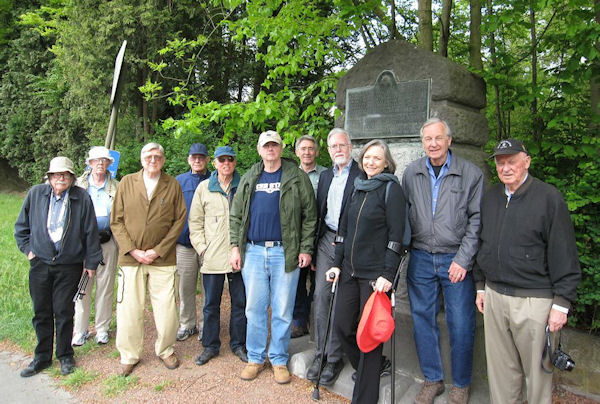
Mons: First Stop for Mike Hanlon's Initial Centennial Battlefield Tour
|
 Mike Hanlon Discussing the
|
I wanted to encourage this nation-wide effort and to play a role myself, by sharing my own understanding of the war and information that I had gathered about it, especially concerning America's effort and sacrifices.
My Centennial work centered around three publications: a daily blog, Roads to the Great War; a monthly newsletter, the St. Mihiel Trip-Wire, and subscription magazine, Over the Top. My unifying approach for these publications—and for my battlefield tour business—was to parallel the Great War as it unfolded 100 years ago, month by month, day by day.
My 2014 tours, for example, covered the opening Battles of the Frontier and the First Battle of the Marne on the anniversaries of the fighting.

Mike Hanlon's WWI Centennial Publications, Still Available at Worldwar1.com
In my publications, those events were also analyzed with in-depth articles and other important events of the year, the run-up to the war, the assassination at Sarajevo, the July Crisis, the Race to the Sea, and the war on the Eastern Front were featured. This practice was repeated for every year of the Centennial.
I thought helping our readers to recall and reconceive the war at the same tempo as the battles and other major crises of the war took place would give them feel for the total phenomenon of the World War, something beyond a summing up of its major happenings. For the Over the Top magazine, especially, I had a team of researchers and editors helping me and was able to gain in-depth articles and analysis for the Centennial series from a long list of historians of the war, such as Stephen Harris, Mitch Yockelson, Robert Doughty, Elizabeth Greenhalgh, John Mosier, and many others. I'm very proud of what we produced.

Mike Hanlon with Mary Jane
and Time Koenig on the Meuse
Heights, August 1918. Mary Jane's
Great Uncle Helped Save the Life of
a Fellow Member of the 90th
Division Along This Road
With my most recent, 144th, and final issue of Over the Top, though, my work on the 100-year cycle is complete. I've begun reflecting on our body of work and have come to ask myself how this experience of researching and publishing articles about all the main events of the war—in conjunction with visiting all its significant battlefields—has affected my thinking and attitudes about the struggle.
Probably my strongest new impression is a sense of what the war was like for those deeply involved with it—soldiers, statesmen, families at home—specifically, how emotionally wearing and exhausting it must have been. There was bad news to absorb every day and a major emergency monthly; no wonder there were such overwhelming expressions of relief and joy when the Armistice came.
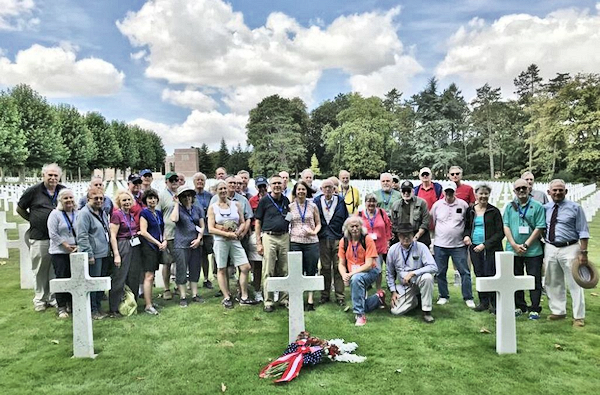
Final Centennial Tour Group: The Battlefields of the American Expeditionary Forces at the Oise-Aisne U.S. Cemetery, August 2018
Another important thing I came to appreciate during the Centennial was how deeply America was involved in the war from its start—August 1914—diplomatically, economically, and through the decisions by individual Americans to get involved in the struggle as soldiers or volunteers despite their own country’s neutrality.
This article originally appeared in the 18 December 2018 issue of The WWI Dispatch, an online publication of the United States World War One Centennial Commission.
| Thanks to each and every one of you who has contributed material for this issue. Until our next issue, your editor, Mike Hanlon. |
|
|
Content © Michael E. Hanlon

